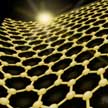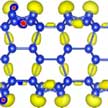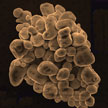Showing Spotlights 17 - 24 of 77 in category All (newest first):
 Due to their excellent electron-transport properties and extremely high carrier mobility, graphene and other other direct bandgap monolayer materials such as transition-metal dichalcogenides (TMDCs) and black phosphorus show great potential to be used for low-cost, flexible, and highly efficient photovoltaic devices. A recent review provides a comprehensive overview on the current state-of-the-art of 2D-materials-based solar photovoltaics. It describes the recent progress made with graphene, graphene-based materials, and other 2D materials for solar photovoltaics, including silicon-based solar cells, and organic and perovskite solar cells.
Due to their excellent electron-transport properties and extremely high carrier mobility, graphene and other other direct bandgap monolayer materials such as transition-metal dichalcogenides (TMDCs) and black phosphorus show great potential to be used for low-cost, flexible, and highly efficient photovoltaic devices. A recent review provides a comprehensive overview on the current state-of-the-art of 2D-materials-based solar photovoltaics. It describes the recent progress made with graphene, graphene-based materials, and other 2D materials for solar photovoltaics, including silicon-based solar cells, and organic and perovskite solar cells.
Jan 7th, 2019
 In the past few years, monolayer and multilayer silicenes have been successfully grown on various metal substrates. Unfortunately, silicene on metal substrate generally exhibits metallic or semi-metallic character without a bandgap, and thus cannot be used as adsorption layer of photovoltaic materials. A new comprehensive investigation of multilayer silicene by means of ab initio swarm-intelligence structure-searching method predicts that tri-layer silicene is an ideal candidate for high-efficiency photovoltaic absorbers.
In the past few years, monolayer and multilayer silicenes have been successfully grown on various metal substrates. Unfortunately, silicene on metal substrate generally exhibits metallic or semi-metallic character without a bandgap, and thus cannot be used as adsorption layer of photovoltaic materials. A new comprehensive investigation of multilayer silicene by means of ab initio swarm-intelligence structure-searching method predicts that tri-layer silicene is an ideal candidate for high-efficiency photovoltaic absorbers.
Oct 15th, 2018
 Steam is important for desalination, hygiene systems, and sterilization; and in remote areas where the sun is the only source of energy, being able to generate steam with solar energy could be very useful. Researchers now have found that the mushroom structure can surprisingly benefit solar steam generation. The stipe of the mushroom can serve as efficient water supply path, meanwhile, due to the extreme small ratio of the areas of fibrous stipe and black pileus, only little heat (useless heat loss) conducted into water.
Steam is important for desalination, hygiene systems, and sterilization; and in remote areas where the sun is the only source of energy, being able to generate steam with solar energy could be very useful. Researchers now have found that the mushroom structure can surprisingly benefit solar steam generation. The stipe of the mushroom can serve as efficient water supply path, meanwhile, due to the extreme small ratio of the areas of fibrous stipe and black pileus, only little heat (useless heat loss) conducted into water.
Jun 6th, 2017
 The growing need for 'green' energy sources combined with silicon solar cells' stagnating power conversion efficiencies have lead to a keen search for an alternative to silicon that would bring about a major change. Perovskite solar cell technology, boasting potential for high efficiency, low-cost scalable photovoltaic solar cells, may just be a suitable contender in this race. Perovskites, a class of materials that share a similar structure, display a myriad of exciting properties that position them as attractive candidates for enabling low-cost, efficient photovoltaics that could even be sprayed onto rooftops and various other surfaces.
The growing need for 'green' energy sources combined with silicon solar cells' stagnating power conversion efficiencies have lead to a keen search for an alternative to silicon that would bring about a major change. Perovskite solar cell technology, boasting potential for high efficiency, low-cost scalable photovoltaic solar cells, may just be a suitable contender in this race. Perovskites, a class of materials that share a similar structure, display a myriad of exciting properties that position them as attractive candidates for enabling low-cost, efficient photovoltaics that could even be sprayed onto rooftops and various other surfaces.
Dec 1st, 2016
 Scientists have now demonstrated in detail how chemical purity of perovskite precursors can affect the morphology of thin-film perovskite layers. While most studies concentrate on the exploration of processing conditions, the research team has investigated the purity levels of common perovskite precursor solutions and found a number of impurities that are critically important toward controlling the crystallization of perovskites. They observed that impurities that formed during the preparation of perovskite precursor solutions initiate formation of PbHPO3 nanoparticles, which helps to growth larger perovskite crystal grains resulting in higher solar cells efficiency.
Scientists have now demonstrated in detail how chemical purity of perovskite precursors can affect the morphology of thin-film perovskite layers. While most studies concentrate on the exploration of processing conditions, the research team has investigated the purity levels of common perovskite precursor solutions and found a number of impurities that are critically important toward controlling the crystallization of perovskites. They observed that impurities that formed during the preparation of perovskite precursor solutions initiate formation of PbHPO3 nanoparticles, which helps to growth larger perovskite crystal grains resulting in higher solar cells efficiency.
Nov 15th, 2016
 Solar cells absorb incoming sunlight and convert a part of photon energy into electricity. The remainder of photon energy is dissipated as heat. Although the idea is rather counter-intuitive, 'reverse solar cell' systems can also generate electric power by emitting rather than absorbing photons. Such systems - known as thermoradiative cells - generate voltage and electric power via non-equilibrium thermal radiation of infrared photons. Thermoradiative cells offer an opportunity to generate clean energy by harvesting radiation from largely untapped terrestrial thermal emission sources, potentially including the Earth itself.
Solar cells absorb incoming sunlight and convert a part of photon energy into electricity. The remainder of photon energy is dissipated as heat. Although the idea is rather counter-intuitive, 'reverse solar cell' systems can also generate electric power by emitting rather than absorbing photons. Such systems - known as thermoradiative cells - generate voltage and electric power via non-equilibrium thermal radiation of infrared photons. Thermoradiative cells offer an opportunity to generate clean energy by harvesting radiation from largely untapped terrestrial thermal emission sources, potentially including the Earth itself.
Oct 14th, 2016
 Newly developed nanocomposites possess efficient photothermic properties for highly targeted interfacial phase transition reactions that are synergistically favorable for seawater catalysis and desalination. The nanocomposites are seawater and photostable for practical solar conversion of seawater to simultaneously produce clean energy and water. This work defines the forefront of plasmonic photothermic technology, which is vastly untapped and has broad implications in other fields.
Newly developed nanocomposites possess efficient photothermic properties for highly targeted interfacial phase transition reactions that are synergistically favorable for seawater catalysis and desalination. The nanocomposites are seawater and photostable for practical solar conversion of seawater to simultaneously produce clean energy and water. This work defines the forefront of plasmonic photothermic technology, which is vastly untapped and has broad implications in other fields.
Jul 12th, 2016
 Although developed only recently, inorganic halide perovskite quantum dot systems have exhibited comparable and even better performances than traditional quantum dots in many fields. They are expected to be applied in display and lighting technologies. Researchers now have reported an interesting cyclable surface dissolution and recrystallization phenomenon of inorganic perovskite crystals. This allows them to freely change size between nanometer and micrometer scales, and can be used to healing the defects inside perovskite films and hence improve the performances of optoelectronic devices.
Although developed only recently, inorganic halide perovskite quantum dot systems have exhibited comparable and even better performances than traditional quantum dots in many fields. They are expected to be applied in display and lighting technologies. Researchers now have reported an interesting cyclable surface dissolution and recrystallization phenomenon of inorganic perovskite crystals. This allows them to freely change size between nanometer and micrometer scales, and can be used to healing the defects inside perovskite films and hence improve the performances of optoelectronic devices.
Jul 7th, 2016
 Due to their excellent electron-transport properties and extremely high carrier mobility, graphene and other other direct bandgap monolayer materials such as transition-metal dichalcogenides (TMDCs) and black phosphorus show great potential to be used for low-cost, flexible, and highly efficient photovoltaic devices. A recent review provides a comprehensive overview on the current state-of-the-art of 2D-materials-based solar photovoltaics. It describes the recent progress made with graphene, graphene-based materials, and other 2D materials for solar photovoltaics, including silicon-based solar cells, and organic and perovskite solar cells.
Due to their excellent electron-transport properties and extremely high carrier mobility, graphene and other other direct bandgap monolayer materials such as transition-metal dichalcogenides (TMDCs) and black phosphorus show great potential to be used for low-cost, flexible, and highly efficient photovoltaic devices. A recent review provides a comprehensive overview on the current state-of-the-art of 2D-materials-based solar photovoltaics. It describes the recent progress made with graphene, graphene-based materials, and other 2D materials for solar photovoltaics, including silicon-based solar cells, and organic and perovskite solar cells.
 Subscribe to our Nanotechnology Spotlight feed
Subscribe to our Nanotechnology Spotlight feed





